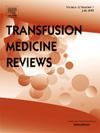Isohemagglutinin titres: A comparison of pathogen reduced pooled platelets manufactured with platelet additive solution versus untreated pooled platelets
IF 2.5
2区 医学
Q2 HEMATOLOGY
引用次数: 0
Abstract
Introduction
Limitations in platelet inventory necessitate the use of ABO-incompatible (ABOi) platelets for transfusion with possible risk of an acute hemolytic transfusion reaction due to the presence of high titre (HT) isohemagglutinins (ISO). Pooled platelets psoralen-treated (PPPT) are manufactured following the division of 7 donor buffy coats in a platelet additive solution (PAS). The PAS:plasma ratio of 60:40 provides a dilutional effect on ISO levels. The purpose of this study is to compare the proportion of PPPT that test ISO HT positive versus untreated 4 donor platelet pools without PAS (UPP).
Methods
Component-based ISO titration was performed on 1001 UPP (November 8 2022-February 8 2023) and 1019 PPPT (June 1 2023-August 31 2023) followed by testing of 834 additional group O PPPT (September 1 2023-January 19 2024) to refine the HT rate estimate. All testing was performed at a single laboratory by a manual immediate spin tube method using an aliquot of platelet supernatant diluted 1:50 with saline tested separately against A1 and B cells. Agglutination with either/both A1 and B cell(s) constituted a positive HT result. The proportion of components with HT results were compared for PPPT vs UPP. Statistical analysis was performed using SAS with P-values calculated using the chi-square method.
Results
Of 1019 PPPT in PAS, 3 (0.29%) tested HT positive and all were group O. By comparison, 64/1001 (6.4%) UPP were HT positive (P-value <.0001). The rate of HT positivity by ABO blood group for PPPT vs UPP: Group O 3/559 (0.54%) vs 53/496 (10.6%) (P-value <.0001); Group A 0/439 (0%) vs 9/468 (1.9%); Group B 0/21 (0%) vs 2/37 (5.4%). For group A and B platelets, the relatively low rate of HT positive events in both UPP and PPPT precluded meaningful statistical comparison. Testing of 834 additional group O PPPT yielded 6 HT positive components for a total of 9/1393 (0.65%) HT positive group O PPPT (99% CI 0.23-1.43%).
Conclusions
Greater than 99% of pathogen reduced pooled platelets in PAS have low isohemagglutinin titres using a common component-based testing assay. For PPPT, none of the group A or B tested HT positive with 0.65% positivity in group O. The significant reduction in HT positive pooled platelet components with this new manufacturing method confers a greater safety profile when ABO incompatible platelet transfusion cannot be avoided. These findings may impact hospital decisions around inventory management, platelet selection and titre testing.
异血凝素滴度:使用血小板添加剂溶液制造的病原体减少型集合血小板与未经处理的集合血小板的比较
导言:由于血小板库存有限,必须使用ABO不相容(ABOi)的血小板进行输血,但由于高滴度(HT)异血凝素(ISO)的存在,可能存在急性溶血性输血反应的风险。经补骨脂素处理的血小板池(PPPT)是在血小板添加剂溶液(PAS)中分割 7 个供体水包膜后制成的。PAS 与血浆的比例为 60:40,可对 ISO 水平产生稀释作用。方法对 1001 份 UPP(2022 年 11 月 8 日至 2023 年 2 月 8 日)和 1019 份 PPPT(2023 年 6 月 1 日至 2023 年 8 月 31 日)进行了基于成分的 ISO 滴定,随后又对 834 份 O 组 PPPT(2023 年 9 月 1 日至 2024 年 1 月 19 日)进行了测试,以完善 HT 率估计值。所有测试均在一个实验室进行,采用手动即时旋管法,将等分的血小板上清液与生理盐水以 1:50 的比例稀释,分别对 A1 和 B 细胞进行测试。与 A1 和 B 细胞中的任一种/两种细胞发生凝集即为 HT 阳性结果。比较了 PPPT 与 UPP 的 HT 结果成分比例。结果 在 PAS 的 1019 个 PPPT 中,有 3 个(0.29%)检测出 HT 阳性,且均为 O 组。相比之下,64/1001(6.4%)个 UPP 呈 HT 阳性(P 值为 0.0001)。按 ABO 血型分类,PPPT 与 UPP 的 HT 阳性率分别为:O 组 3/559 (0.54%) vs 53/496(10.6%)(P 值为 <.0001);A 组 0/439(0%) vs 9/468(1.9%);B 组 0/21(0%) vs 2/37(5.4%)。对于 A 组和 B 组血小板,由于 UPP 和 PPPT 中 HT 阳性率相对较低,因此无法进行有意义的统计比较。对另外 834 个 O 组 PPPT 进行检测后发现 6 个 HT 阳性成分,总共有 9/1393 个(0.65%)O 组 PPPT HT 阳性(99% CI 0.23-1.43%)。采用这种新的生产方法后,HT 阳性的血小板成分显著减少,在无法避免 ABO 不相容血小板输注的情况下,安全性更高。这些发现可能会影响医院在库存管理、血小板选择和滴度检测方面的决策。
本文章由计算机程序翻译,如有差异,请以英文原文为准。
求助全文
约1分钟内获得全文
求助全文
来源期刊

Transfusion Medicine Reviews
医学-血液学
CiteScore
11.60
自引率
0.00%
发文量
40
审稿时长
21 days
期刊介绍:
Transfusion Medicine Reviews provides an international forum in English for the publication of scholarly work devoted to the various sub-disciplines that comprise Transfusion Medicine including hemostasis and thrombosis and cellular therapies. The scope of the journal encompasses basic science, practical aspects, laboratory developments, clinical indications, and adverse effects.
 求助内容:
求助内容: 应助结果提醒方式:
应助结果提醒方式:


